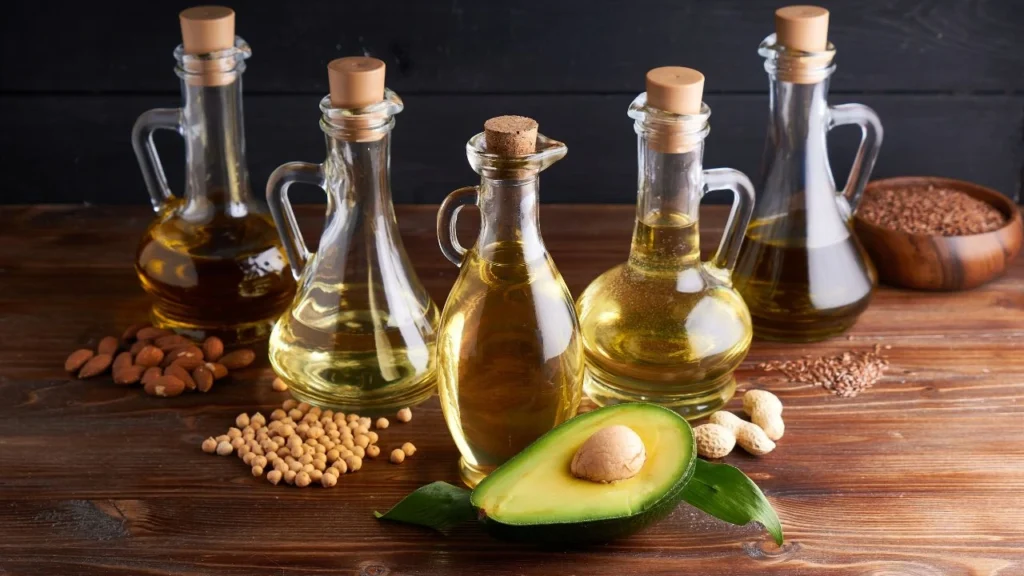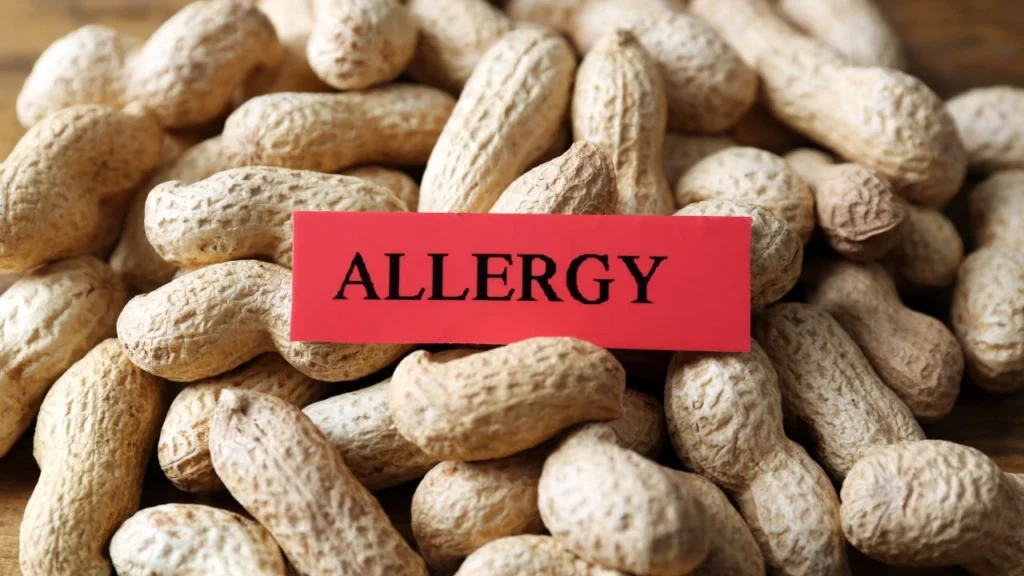I’ve worked in busy kitchens, testing canola oil vs peanut oil. Each oil has its own strengths. I want to share what I learned so you can make a better choice.
Peanut oil has a nuttier flavor. It can handle high temperatures without breaking down. Canola oil, on the other hand, has a light taste and less saturated fat. This makes it great for heart-healthy menu planning.
For food service pros, canola oil vs peanut oil is a key topic. Both oils are good for managing bad cholesterol. Let’s explore their cooking properties and prices further.
Overview of Canola Oil and Peanut Oil
Many chefs choose between canola and peanut oil for their taste and performance. Canola oil has a light taste that lets spices take center stage. It’s a top pick in my kitchen for recipes where spices are the main attraction.
Peanut oil, on the other hand, adds a strong, nutty flavor. It can turn simple dishes into something more exciting. Both oils have different smoke points, which affect how they handle heat.
Canola oil can get up to 468°F, perfect for busy restaurants. Peanut oil reaches about 450°F, ideal for frying.
Oils and Their Common Uses in Cooking
Canola oil is often used in salad dressings, light sautéing, and baking. Peanut oil is great for crispy fried chicken, stir-fries, and Asian dishes. Canola is better for dishes that need a neutral base. Peanut oil adds a toasty flavor to certain recipes.
- Canola oil fits mild dishes and baked goods.
- Peanut oil stands out in deep-fried and aromatic recipes.
Why Compare These Two Oils?
Every cooking oil comparison should look at taste, heat stability, and how they affect menu variety. Canola’s mild taste is versatile, while peanut oil’s rich flavor is perfect for bold dishes. Understanding these differences helps chefs choose the right oil for their dishes.
Health Benefits

When I compared these two oils for my kitchen lineup, I noticed a key takeaway. Focusing on nutrients can attract health-conscious customers and keep dishes flavorful. This insight helped me see how the benefits of canola oil can make it stand out on a menu.
In my experience, nutritious options can elevate a restaurant’s reputation. Canola oil offers 41% of daily vitamins, while peanut oil provides 24%. Canola oil is also lower in saturated fat by about 56.4% and has 37% more monounsaturated fat. Peanut oil has 13.7% more polyunsaturated fat, which might be better for some cooking methods but adds more saturated fat overall.
Nutritional Profile Comparison
Both oils have the same amount of protein, cholesterol, sugar, and sodium. But canola oil has more vitamin K, with 71.3µg compared to peanut oil’s 0.7µg. This means it gives an extra nutritional boost that many customers value.
Effects on Heart Health
I’ve found that using canola oil can help manage bad cholesterol levels. This is because it has more monounsaturated fat. This fat type often helps the heart by supporting healthy HDL levels. Chefs looking for the benefits of canola oil can use it in heart-friendly recipes.
Cooking Properties

As a chef, I’ve seen how an oil’s heat tolerance can make or break a dish. Stable options help avoid off-flavors and wasted batches. Let me share what I’ve learned over the years.
Smoke Points and Stability
Peanut oil hits high temperatures without burning. This makes it great for deep-frying or stir-frying. It keeps flavors intact.
Canola oil typically holds up around 400 to 450 degrees Fahrenheit. This is enough for many sauté tasks and gentle frying.
Flavor Profiles
I’ve always liked peanut oil’s nutty note, though it can overshadow subtle ingredients. Canola oil stays mild, letting other flavors shine through. This balance can be a game-changer when crafting dishes for diverse menus.
Using either oil wisely helps me reduce cost by cutting down on throwaways.
Dietary Suitability
I’ve helped diners on strict diets find the right oil. Canola oil is a good choice because it’s low in saturated fat. It also causes fewer allergic reactions than peanut oil.
Some chefs say canola oil is cheaper than peanut oil. This helps save money while still meeting health goals.
It’s important to check labels for diet compatibility. For heart-healthy menus, canola oil is a better choice. But, if you like a nutty taste, peanut oil is okay if you’re not allergic.
Compatibility with Popular Diets
People on low-carb or plant-based diets like lighter oils. Canola oil is good for heart health because it’s low in saturated fat. It also tastes neutral.
Peanut oil is still a good option if it fits the dish’s flavor and you’re not allergic.
Allergy Concerns

I worked in a busy kitchen where a single peanut could cause serious health issues. Peanut oil added flavor and could handle high heat, but we had to watch out for cross-contact. Every time I stored or labeled our cooking stations, the risk felt higher.
Peanut Allergies
About 1% to 2% of people in Western countries are allergic to peanuts. Some say 3 million Americans have this allergy. A single peanut can cause a strong reaction. Refined peanut oil has less protein, but tiny amounts might still be there.
This means we must always follow safety rules in any food place.
Alternatives to Peanut Oil
Canola oil is a good choice when peanut oil is not safe. It works well for stir-frying and doesn’t have nut proteins. But, we still need to clean equipment and keep frying areas separate.
Knowing about safe oils helps your kitchen serve everyone safely.
Price and Availability
Every detail in a commercial kitchen is affected by budget decisions. Finding the right balance between flavor and profit is easier when you track wholesale prices. Canola oil is a good choice for everyday use because it’s affordable.
Cost Comparison
Peanut oil is pricier but its rich taste makes it worth it for special dishes. I’ve ordered large amounts of peanut oil for unique menu items. Keeping an eye on market changes helps avoid budget surprises and ensures consistent quality.
Accessibility
Canola oil is easy to find in most places, keeping supplies steady. Peanut oil is also widely available, but some areas might see delays. I prioritize building strong relationships with suppliers and watching for seasonal changes. This approach helps keep costs and access consistent, supporting both the health benefits and the unique flavors of a restaurant.
Environmental Impact

I’ve noticed more people looking for eco-friendly options. They ask which oil is better for them and the planet. This makes me explore how oils are made and where they come from.
Working with suppliers who use organic canola oil has been a highlight. It’s a step towards using fewer pesticides. Growing peanuts organically also helps the soil. These choices appeal to those who care about the environment.
Sustainability of Production
Choosing expeller-pressed and non-GMO oils can help the environment. But, remember, canola oil production uses a lot of fertilizer, which can harm water. Peanuts are often grown with cotton, which has its own environmental issues.
By offering oils that are better for the planet, you show you care. This attracts customers who value both their health and the environment.
Canola Oil vs Peanut Oil Recommendations
I looked at 48 research reviews and saw how different oils affect us. Oils like canola oil, rich in good fats, can lower bad cholesterol and help with weight. On the other hand, oils high in saturated fats might increase total cholesterol but help control blood sugar.
Peanut oil adds a unique flavor to food but might raise the risk of Type 2 diabetes. These studies show that the type of oil we use can impact our health over time, especially if we use a lot of it.
Choose oils based on how you cook, what you like to taste, and your health goals. Canola oil is great for heart health and cooking at moderate heat. Peanut oil is perfect for adding a strong flavor and for frying.
Remember, peanut oil might not be good for everyone, especially if you have allergies or are at risk for Type 2 diabetes. Pick the oil that makes your dishes special and use it in the right amounts to keep your meals balanced. Additionally, we have prepared a guide for you on choosing the best oil for a deep fryer.
Resources
https://www.healthpartners.com/blog/healthy-cooking-oils
https://foodstruct.com/compare/canola-vs-peanut-oil
https://www.globalsavors.com/blog/fats-and-edible-oils/canola-oil/peanut-oil-vs-canola-oil
https://www.cloverhealth.com/blog/8-types-of-cooking-oils-and-when-to-use-them






